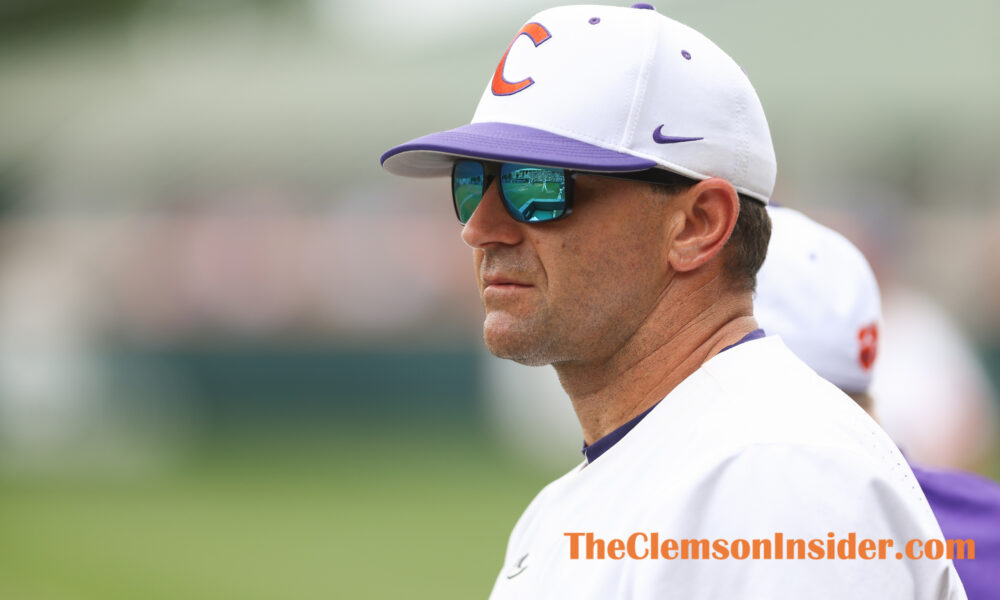CLEMSON —Erik Bakich has a message for Clemson fans, and he needs them to understand it.
If Clemson people do not start helping the 110 Society, Clemson’s new and only collective, then it is going to be difficult for Clemson Athletics to compete with its closest competitors in the ACC and nationally.
“It is mission critical for our success, for our fans, donors and people who love Clemson and support the Clemson student-athletes,” Bakich said in an interview with The Clemson Insider. “I think it is just having an understanding of the global landscape of college athletics now and how it has shifted.
“The cost of doing business in player acquisition, recruiting and transfer portal, it has changed, especially for an equivalency sport like baseball, soccer or softball or any sport that does not have full scholarships.”
Bakich said last summer, and again last week to TCI, that the baseball program needs a million NIL dollars to continue to compete at a high level. The million dollars in NIL funds will allow all of Clemson’s baseball players the ability to pay for their scholarships in full.
“It is even more critical because getting a good player with a combination of a scholarship plus NIL, it is just the way it is now and it is just the way the landscape has changed,” Clemson’s head baseball coach said. “What has not changed is the total amount of the scholarship which is still allocated from the NCAA. The landscape has changed, but our budget is still the same when it comes to what we have.”
What Clemson baseball has is 11.7 scholarships, per NCAA rules, to divide amongst 40 players.
“NIL can be this incredible thing to bridge the gap for those out-of-pocket-cost to pay tuition, to pay our housing and to pay the cost of attendance to come to Clemson,” Bakich said. “We are recruiting at least a fifty-fifty blend of in-state and out of state (players), which means we are going to need to raise over a million dollars every year if we want to get to that point where a lot of teams have and that is to just pay the cost of attendance.
“Right now, that is being paid by our (players’) families to the school.”
And that is something players at other schools are not doing. They are not only receiving enough NIL funds to pay their tuition in some cases, but they are also receiving spending dollars for their everyday cost of living and other expenses.
“The (tuition) is being paid, but the difference now is that other teams that Clemson University is competing against have a bigger treasure trove and have a bigger discretionary fund,” Bakich said. “They already have their collectives that have been around a couple of years, so they already have a deeper pocket to pull from.
“I just want to make this point really clear for all Clemson fans and donors, because the initial reaction when you hear NIL is this cringe. This slimy thing of greed and players just trying to line their pockets.”
Bakich said NIL is not like that at all, and Clemson fans need to get a better understanding of what NIL does for the players, which in turn helps the overall health of the athletic programs.
“It’s not like that, and I need to be super clear on this. Equivalency sport athletes are using NIL to pay their tuition bill. To pay their cost of attendance,” he said. “We have players on twenty-five percent of a scholarship, fifty-percent scholarship who are looking to get NIL dollars to pay their bills. It is not pay for play. It is to pay your bills. That is what it is for.”
The problems do not stop there for some of Clemson’s student athletes. Not only are they still paying for some or most of their tuition costs, but they are also getting taxed for the NIL dollars they do make.
“This is a major problem. Our student athletes are taxed on their NIL dollars. We have student-athletes, baseball players, soccer players, softball players—equivalency sport athletes—who are getting NIL dollars that are not on a full scholarship and getting taxed on those dollars to pay those scholarships,” Bakich said. “But a scholarship is tax free. It is not income.
“The other problem is who is paying that NIL money? That is the donors, but NIL is not a tax benefit. It is not a charity. It is not a 501-C3. There are no tax benefits to giving NIL dollars or giving to a collective, which means a donor is giving after-tax-dollars. If they are in a 35-percent tax bracket, they have to earn $1.35 to give a dollar. That is a problem as well.”
Bakich says Clemson has its share of struggles ahead, including the baseball program, but those fans that can give to the 110 Society can go a long way in fixing those struggles.
“We and every other equivalency sport athlete on this campus needs those dollars, need that help, need that NIL support to help cover the cost of attendance,” he said. “It is imperative. It is mission critical, and it is going to be a huge driver for our success moving forward.”
